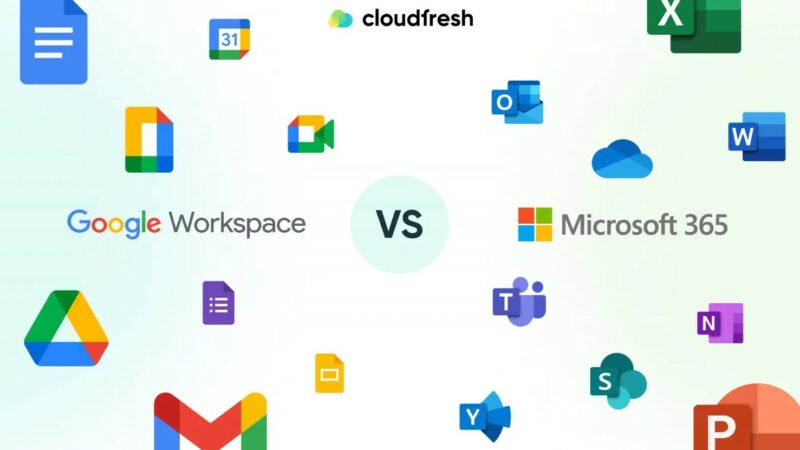Google Workspace vs. Microsoft 365: Which is Better for Education?

Introduction:
- Start by addressing the importance of digital tools in education.
- Introduce the two major players in the field: Google Workspace and Microsoft 365.
- Highlight that the article will explore the pros and cons of both platforms in the educational context.
1. What is Google Workspace for Education?
Subtitle: Understanding Google’s Suite for Education
- Define Google Workspace for Education.
- Briefly explain the key features of Google Workspace, such as Google Docs, Sheets, Drive, Classroom, and Meet.
- Mention the free offerings for schools and the flexibility of the platform.
Optimization Tips:
- Use keywords like “Google Workspace Education,” “free Google Workspace for schools,” and “cloud-based education tools.”
- Link to relevant Google Education resources.
2. What is Microsoft 365 for Education?
Subtitle: Microsoft’s Comprehensive Education Suite
- Define Microsoft 365 for Education.
- Highlight core tools like Word, Excel, PowerPoint, OneDrive, Teams, and OneNote.
- Mention Microsoft’s commitment to education, including free plans for schools and students.
Optimization Tips:
- Include terms like “Microsoft Office for Education,” “Microsoft Teams in Education,” and “cloud storage for students.”
- Provide a link to Microsoft 365 Education features.
3. Key Differences Between Google Workspace and Microsoft 365
Subtitle: Comparing Core Features
- Collaboration Tools:
- Google Workspace’s real-time collaboration via Docs, Sheets, and Slides.
- Microsoft 365’s collaboration via Word, Excel, PowerPoint, and Teams.
- Pros and cons of real-time editing and team collaboration.
- User Interface and Ease of Use:
- How the interfaces of both platforms cater to students and educators.
- Discuss the simplicity of Google Workspace vs. the familiarity of Microsoft tools.
- Cloud Storage:
- Google Drive vs. OneDrive: Which one offers better value and storage options for educational institutions?
Optimization Tips:
- Use phrases like “real-time collaboration for students,” “cloud storage for education,” and “easy-to-use educational tools.”
- Include comparison tables for easy readability.
4. Pricing for Education: Google Workspace vs. Microsoft 365
Subtitle: Cost-Effectiveness for Schools and Students
- Discuss Google Workspace’s free offerings for education and pricing tiers.
- Discuss Microsoft 365’s free educational plan and the various paid plans available.
- Compare the cost-benefit analysis of both platforms for schools and universities.
Optimization Tips:
- Use keywords like “free tools for education,” “affordable educational software,” and “pricing for educational institutions.”
- Link to official pricing pages.
5. Security and Privacy Considerations
Subtitle: Which Platform Offers Better Protection for Students and Schools?
- Compare the security features of both platforms.
- Google Workspace’s built-in security features and admin controls.
- Microsoft 365’s enterprise-level security options.
- Discuss compliance with educational data protection laws (e.g., FERPA, GDPR).
Optimization Tips:
- Use terms like “educational data security,” “data privacy for schools,” and “student information protection.”
- Include internal or external links to security policies.
6. Integration with Other Tools and Platforms
Subtitle: Expanding the Use of Digital Tools in the Classroom
- Discuss how each platform integrates with third-party apps and educational tools.
- Google Workspace’s integrations with Google Classroom and other Google services.
- Microsoft 365’s integration with Microsoft Teams and educational apps like Flipgrid.
Optimization Tips:
- Use phrases like “classroom tool integrations,” “third-party educational apps,” and “digital learning environment.”
- Mention specific educational apps supported by both platforms.
7. Conclusion: Which is Better for Education?
Subtitle: Making the Right Choice for Your Educational Institution
- Recap the main points covered in the article.
- Offer recommendations based on the needs of different types of educational institutions (e.g., K-12 schools, universities).
- Conclude by emphasizing that both platforms have their strengths and the best choice depends on the institution’s specific needs.
Optimization Tips:
- Use phrases like “best digital tools for education” and “choosing the right education software.”
- Encourage readers to consider their unique requirements before making a decision.
Call to Action (CTA):
- Invite readers to share their experiences with Google Workspace or Microsoft 365 in the comments.
- Include a link to further reading or resources related to digital literacy and education tools.
By following this structure, your content will be comprehensive, informative, and optimized for search engines while being valuable for readers interested in digital tools for education.
Comments are closed.